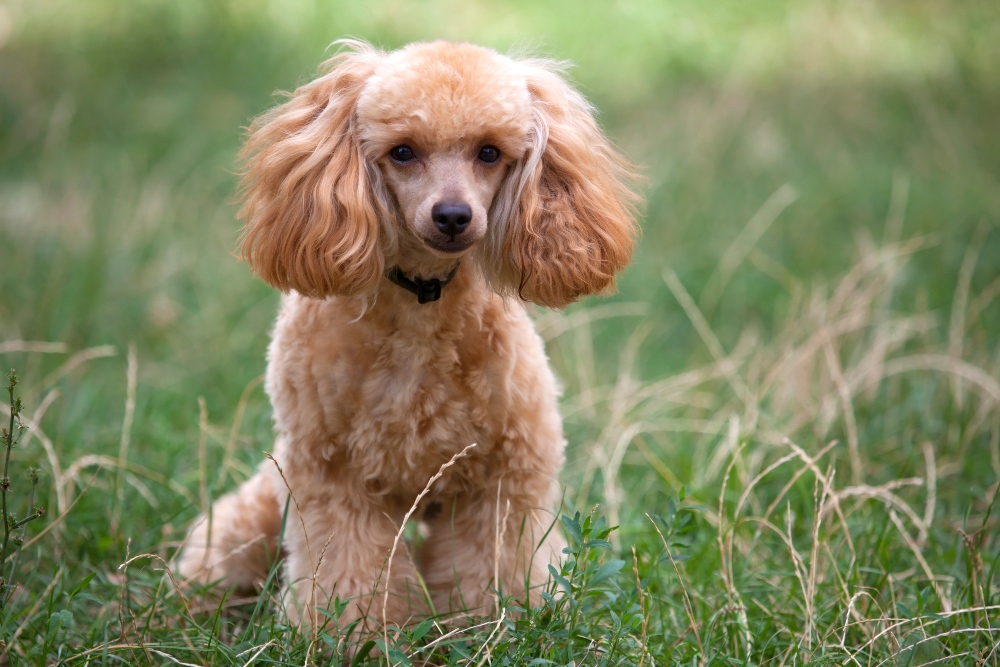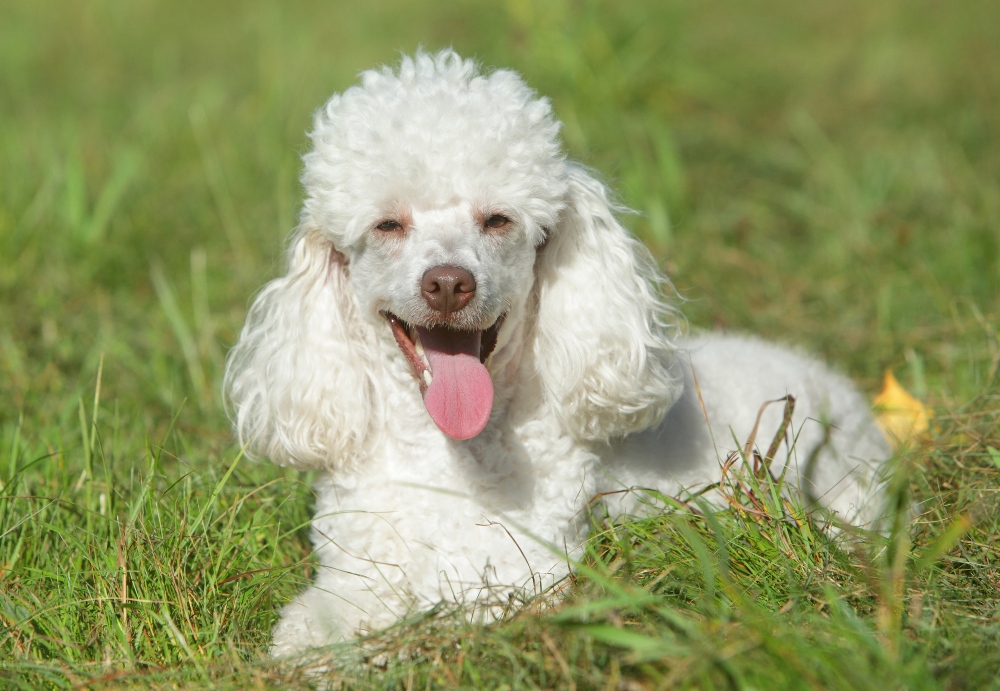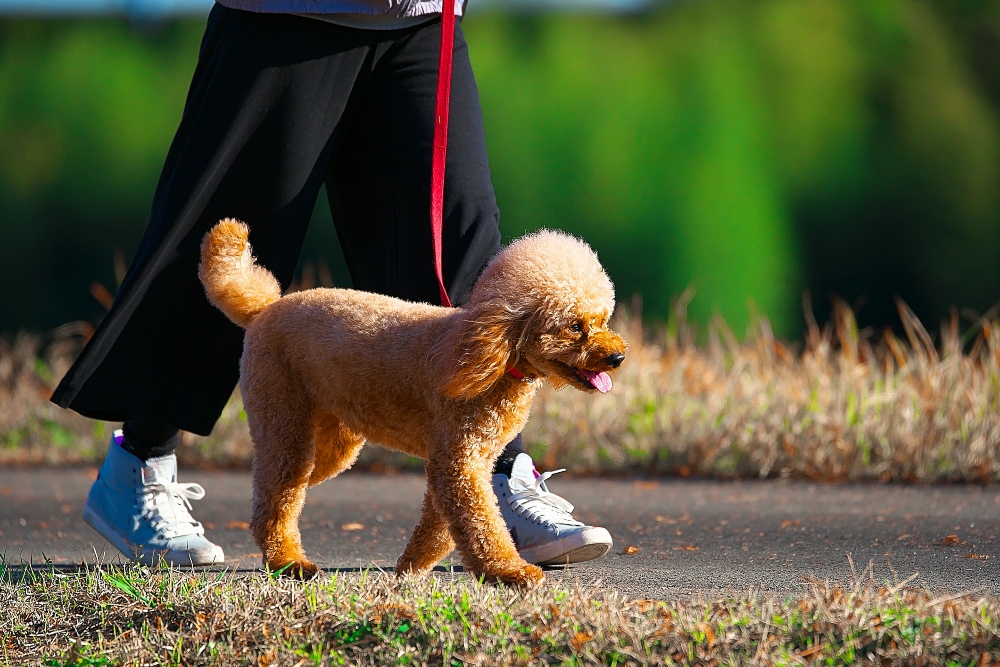Table of Contents
Introduction to Miniature Poodles
Many different dog breeds have been miniaturized over the years, but few of them have become as popular as the miniature poodle. Miniature poodles are smart, proud, and active dogs that have a distinctive look and also a reputation of being both prissy and athletic.
People looking to bring a spirited and trainable dog into their families might consider a miniature poodle if they don’t have a large enough home or yard for a standard size poodle. First-time pet parents may also choose miniature poodles because they are easy to housebreak, sociable with other animals, playful with family members, and very attentive in disposition.
Size of Miniature Poodles
Miniature poodles weigh about 10 to 15 pounds and are about 10 to 15 inches tall when fully grown. By contrast, standard poodles are over 15 inches tall and weigh 40 to 50 pounds for females and 60 to 70 pounds for males. Therefore, miniature poodles are considerably smaller than the original breed, even though they have many of the same characteristics and a similar appearance.
Here’s how big you can expect your miniature poodle to get when fully grown. Females weigh in on the low end of these weight ranges, while males tend to be at the upper range of these figures.
| Weight Chart | 4 months | 6 months | 9 months | 12 months | 15 months |
|---|---|---|---|---|---|
| Male and Female Miniature Poodles | 4-6 pounds | 6-9 pounds | 8-12 pounds | 9-14 pounds | 10-15 pounds |
Most miniature poodles are done growing by about one year of age, but your pup might still pack on an extra pound or so between months 12 and 14. The biggest growth spurt is usually between month five and six. However, your miniature poodle’s diet and exercise habits can greatly affect growth at all stages of puppyhood.
Characteristics of Miniature Poodles
Known as wonderful family dogs and for their gentle demeanor, miniature poodles are low-allergen dogs that work well as loyal companions in many households. All types of poodles require a substantial amount of grooming, although you can have your dog’s coat cut in certain ways to make it less high-maintenance.
In terms of energy, miniature poodles tend to be a little more hyper than the larger standard poodles, yet less hyper than the smaller toy poodles. Miniature poodles are quite vocal, which is something to be aware of if you live close to neighbors. They are often devoted to one person more than any other, which makes them work well in single-person households too.
As you get to know a miniature poodle’s personality, here’s what you can expect based on his or her breed characteristics.
| Breed Characteristic | Level (High, Medium, Low) |
|---|---|
| Affectionate with People | High |
| Good with Kids | High |
| Good with Pets | High |
| Need for Exercise | Medium |
| Energy Level | High |
| Intelligence Level | High |
| Able to Be Trained | High |
| Amount of Barking | High |
| Amount of Shedding | Low |
History of Miniature Poodles
The history of the poodle actually dates back to Germany more than 400 years ago, in spite of the poodle being the national dog of France. Poodles were originally used as duck hunters and retrieving dogs in the water because of their curly, protective coats and athletic abilities. Poodles are excellent swimmers and exceptional learners. Many famous people have had poodles throughout history, including U.S. presidents and royal aristocrats in Europe. Poodles of varying sizes have also been used in circuses because of their ability to learn tricks and perform well.
But over time, poodles became known as luxurious dogs and bred down to smaller sizes so that they could be lap dogs. Miniature poodles are classified by the American Kennel Club as a non-sporting dog and eligible for AKC Retriever and Spaniel Hunting Tests.
Miniature Poodle Standard Information
Standard and miniature poodles are recognized as an official breed by the American Kennel Club, and therefore, there is established breed standard information available to judge these dogs at shows. This standard information is the same for toy, miniature, and standard size poodles.
Here is an overview of the breed standard information for miniature poodles:
Head:
- Dark, oval eyes
- Moderately rounded skull
- Long, straight, and fine muzzle
- Teeth with a scissors bite.
Neck, Topline, Body:
- Level topline, not sloping
- Deep and moderately wide chest
- Straight tail, set on high and carried up
Forequarters:
- Strong and smoothly muscled shoulders
- Forelegs straight and parallel when viewed from front
Hindquarters:
- Angulation of hindquarters balances forequarters
- Hindlegs straight and parallel when viewed from rear
Coat:
- Curly or corded coat
- Can be shown in puppy, English saddle, or continental clips
Color:
- Even and solid color at skin
- Black, white, apricot, gray, silver, and brown colors
- Natural variation in shading is not a fault
Gait:
- Straightforward trot with light springy action
- An air of distinction and dignity
Caring for Miniature Poodles
Taking good care of a miniature poodle is no easy task. These dogs need a substantial amount of exercise and mental stimulation every day to live their best lives. They also require frequent grooming, attention, and regular checkups to monitor health conditions that the breed is prone to.
Here are some general tips for taking the best care of a miniature poodle:
Best Living Environments:
- Houses or apartments
- Homes with or without a yard are okay
- Requires less space than standard poodles
- Families with children, dogs, and cats
Type of Exercise:
- Challenging agility courses
- Play sessions in a yard
- Daily walks
- Swimming in safe water
Mental Enrichment:
- Agility courses for mental stimulation as well as physical exercise
- Challenging toys to play with and discover treats
Training Strategies:
- Responds well to training
- Train early on not to bark unnecessarily
- Socialize with other dogs
Grooming Tips:
- Brush every other day for short coats
- Minimize matting with regular grooming
- Clip the coat every month for easier maintenance
Common Health Problems of Miniature Poodles
Miniature poodles have varied life expectancies, ranging from 10 to 18 years. These dogs are prone to several hereditary conditions based on how they have been bred and evolved over the years. Most miniature poodles will live between 13 and 15 years, all the while making many happy memories with their human companions.
These are some of the most common health issues that arise with miniature poodles:
- Legg-Calve-Perthes disease
- Progressive retinal atrophy
- Epilepsy
- Patella luxation
- Cataracts
- Trichiasis
- Entropion
- Lacrimal duct atresia
- Urinary stones
- Intervertebral disk degeneration
Other issues that you might run into with a miniature poodle are ear infections, runny eyes, skin allergies, heart disease, and premature graying of the coat. To take the best care of your miniature poodle, veterinarians often recommend having your pup’s eyes, hips, and knees tested. Having a DNA test to check for progressive retinal atrophy is also a good idea for miniature poodles.
Diet and Nutrition for Miniature Poodles
Miniature poodles do not typically have dietary issues and are fairly easy-going with food. They are not as picky of eaters as some other dog breeds of similar sizes. Choose dry dog foods that have high-quality grains and proteins. Sweet potatoes and brown rice are good ingredients to look for in miniature poodle foods.
As a general rule, feed your miniature poodle about one cup of dry dog food per day. You can reduce this amount slightly if your dog is not very active. Otherwise, you will be putting your miniature poodle at risk for obesity. Most pet parents feed miniature poodles twice per day, in the morning and again in the evening. Feeding your dog in two eating sessions rather than leaving food out all day is another effective way to prevent obesity in your miniature poodle.
Specific brands of dog food that are recommended for miniature poodles are Royal Canin Poodle Adult Dry Dog Food and Wellness Small Breed Complete Health Dry Dog Food.
Where to Adopt or Purchase Miniature Poodles
If you are looking to buy a purebred miniature poodle puppy from a breeder, you can expect to pay between $900 and $2,000 for your pet depending on the puppy’s pedigree. Miniature poodle puppies tend to be in high demand in the U.S. and Europe. The Poodle Club of America is a parent club for the breed and nonprofit organization that offers resources for reputable breeders and general information about these types of dogs.
Alternatively, you may be able to adopt a miniature poodle who is in need of a loving home from a rescue group. PetFinder.com and Adoptapet.com are websites that help you find specific breeds of dogs that are available for adoption near you. There are also local and regional rescue groups that are devoted to miniature poodles in various parts of the country.
Related Breeds
Miniature poodles are very unique dogs, but there are other similar types of dogs that you might be interested in as well if you love the poodle breed. Here are some additional dogs to learn about before you decide to purchase or adopt a miniature poodle:
- Irish water spaniel
- Lagotto Romagnolo
- Barbet
- Toy poodle
- Standard poodle
- Bichon Frise
- French bulldog
- Lhasa apso
- Lowchen
Pet Insurance for Miniature Poodles
Even despite these dogs’ high intelligence level, athleticism, and good overall health, miniature poodles still get into accidents and become sick for a variety of reasons. Whether your miniature poodle is just a few months old, a senior dog, or somewhere in between, pet insurance is highly recommended for this breed. Healthy Paws offers pet insurance plans for miniature poodles that cover new accidents and illnesses that your dog suffers from so that you can only worry about your pup’s health and not how you’ll pay for the high cost of vet bills.
To learn more about what a Healthy Paws pet insurance plan would cost for your miniature poodle and what it will cover, request a quote on our website or call us at 855-898-8991.













